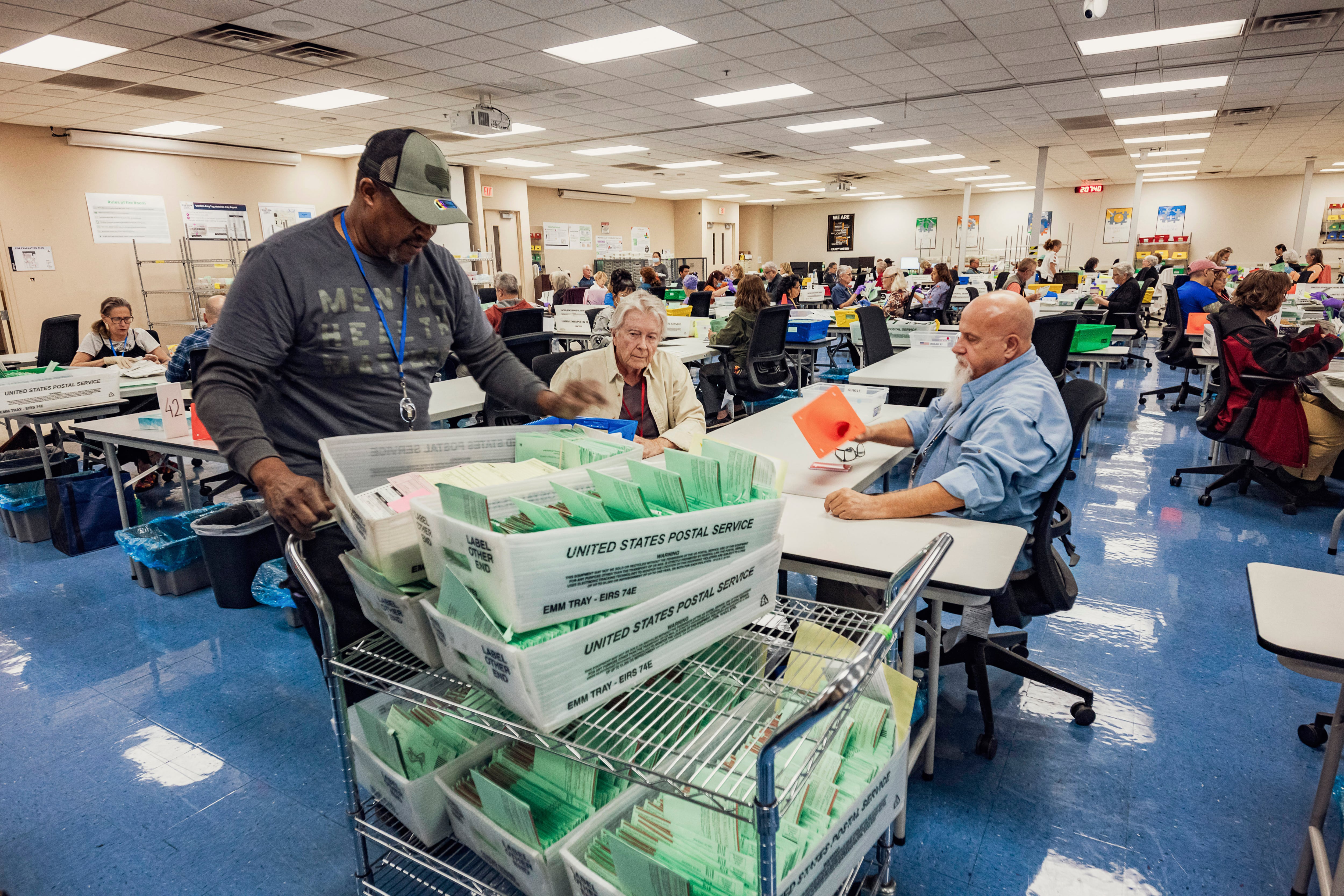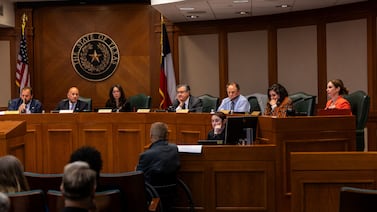Votebeat is a nonprofit news organization reporting on voting access and election administration across the U.S. Sign up for Votebeat Arizona’s free newsletter here.
Results from ballots cast at Maricopa County’s Election Day polling places will be delayed due to a Republican-backed change in state law, a lag that could fuel false claims as the nation awaits the outcome of the presidential race.
The expected slowdown stems from a new state law enacted in February that requires poll workers to tally the number of mail ballot envelopes dropped off at the location before they deliver results to the central counting facility. This is just an initial count of the number of ballot envelopes. The votes on these ballots get counted later, after voter signatures on the ballot envelopes are verified.
Still, the task will take time. In past elections, more than 1,500 mail ballots have been dropped off at busy sites on the day of the election.
Maricopa County — one of just a few closely watched swing counties in a later time zone — will not provide an estimate for when officials expect polling place returns.
“As soon as I give a time, I will be held accountable for it until the end of time,” said county elections spokesperson Jennifer Liewer, adding that “the new requirement to count affidavit envelopes is too big of a factor to make a prediction.”
During the primary election, most Maricopa polling places didn’t report results until 10:55 p.m. with final reporting of polling place results at 1:15 a.m. For a few reasons, the results are likely to come even later in the upcoming election.
For one thing, the lines of voters on Election Day are expected to linger after polls close at 7 p.m. local time, and people waiting in line at that time are entitled to vote; during the primary, there were few lines. For another thing, the ballot is far longer than in the past — two sheets, front and back — which means those voters in line late will take longer to make their choices. Poll workers must wait until all voters are finished and the site is closed before beginning the count of dropped-off mail ballot envelopes.
Republicans normally urge election officials to post results as quickly as possible. But Republican state lawmakers pushed for the new counting requirement as a way to ensure that the number of dropped off mail ballots at each site is documented before the ballots are taken to the central counting facility.
They inserted the measure into critical legislation that Democratic and Republican lawmakers were working on to shorten Arizona’s election timeline to meet federal deadlines, even though the counting requirement has nothing to do with that timeline. Gov. Katie Hobbs, a Democrat, signed the bipartisan legislation on Feb. 9.
Hearing that the requirement will delay results on election night, Republican state Rep. Alex Kolodin, who led his party’s advocacy for the measure, said, “this small delay will give voters more time to drink a toast to the improved security of the election system.”
But some voters didn‘t feel this way in November 2020, when counting wasn’t finished the day after Election Day. At the time, Donald Trump’s supporters crowded outside of the Maricopa County election’s center, demanding that the workers stop counting ballots. Since then, including last week, GOP leaders — and Trump backer Elon Musk — have said that the long counting timeline in the county indicates incompetence or fraud.
It’s unclear when media organizations will have enough information to make their call on who won the presidential contest in the state. A large number of the state’s voters wait until Election Day to drop off their mail ballots at a polling place. (In the 2022 election, about a third of Maricopa County voters, or about 290,000 people, did so.) Those ballots aren’t counted until after the voter signature is verified, which happens in the days following Election Day.
In 2020, Democrat Joe Biden defeated Trump by around 10,000 votes in Arizona. In that election, the Associated Press called the state’s presidential contest for Biden shortly before 1 a.m. But in 2022, the AP waited until six days after the election to call the governor’s race for Katie Hobbs, who ultimately won by a 17,000-vote margin.
In what order do Arizona’s election results come in?
Arizonans vote over a period of weeks, by various means — mail, by ballot drop box, early in person, or in person on Election Day. But their votes get tabulated, and the results reported, in a specific order after polls close.
The first results available from Arizona are tallies of all early ballots cast before Election Day, up to a certain point. Typically, these results include all in-person early voting and mail ballots received up to the weekend before the election.
Counties typically upload these early voting results at 8 p.m. on election night.
The next round of results comes from voters who cast ballots in person at the polls on Election Day.
In many counties, including Maricopa County, voters place their completed paper ballots directly into on-site tabulation machines. The results are stored on portable USB drives in the devices and securely transferred back to a central counting facility, where they are uploaded to a results computer.
For the counties that use on-site tabulation machines, the results are available soon after the USB drives are delivered to the central counting facility. Maricopa County releases those results in batches, as they arrive from locations around the county. And all Arizona counties aim to have all Election Day results posted before workers leave for the day.
In November 2020, the first polling place results came in at 10:15 p.m., according to ABC 15 data analyst Garrett Archer, who tracks election night results. In November 2022, Archer said, results from a small number of sites were uploaded at 9:46 p.m., followed by a larger upload at 10:45 p.m.
The county was unable to confirm results timing from prior years. For this year’s August primary, after the new counting requirement was in place, results from a small number of sites close to the central counting facility were uploaded at 9:30 p.m., with more at 10:55 p.m., according to Maricopa’s Liewer.
At some sites during the primary, it took hours for the last voters to leave, the workers to count envelopes, and the USB drives to get to the central counting facilities: The last round of in-person voting results were loaded at 1:15 a.m.
After Election Day, the next results publicly reported are from ballots sent in the mail and received by counties in the days just before the election. Typically, some of those results are posted the following night, once voter signatures are verified.
The last ballots to be counted are those mailed in and received on Election Day, or dropped off at polling places or in ballot drop boxes on Election Day. Typically, counties will update results once a day until all results are in.
More staff, but also more last-minute ballots
The legislation passed this year made other changes that could affect the timing of results.
If workers flag a voter’s mail ballot because of a non-matching signature, or if a voter casts a provisional ballot that requires additional information or documentation in order to count, Arizona law used to permit five business days for the voter to fix the problem. With the new law, lawmakers changed that to five calendar days for this election. This might help counties get all ballots processed and counted sooner.
In 2022, Maricopa County had 99.2% of ballots counted at the end of the five-business-day cure period. It was 13 days before all ballots were counted.
This year, Maricopa County has hired more workers to help verify signatures and get these last-minute ballots counted. In the primary election, that seemed to help. Final results were posted just six days after the election, which was the fastest the county finished counting in at least the last 10 statewide primaries.
But the county is also expecting more last-minute dropoffs of mail ballots — 350,000 compared with 290,000 in November 2022.
In past years, poll workers haven’t had to tally up these dropped off ballots at the polling place, so it’s unclear how many might arrive at the busiest locations this year.
In the primary election, 86,756 voters dropped off mail ballots at polling sites. Seven out of 222 vote centers had more than 1,000 ballots dropped off, according to a Votebeat review of the county’s posted numbers, and most of the rest had hundreds. The busiest site had 1,855 ballots dropped off.
The county is estimating it will take 10 to 12 days to finish counting all ballots for the November election, which is about average compared with previous elections.
But voters should expect races to be called sooner, unless the winning margin is so tight it triggers an automatic recount. The state is scheduled to certify final statewide results on Nov. 25.
Jen Fifield is a reporter for Votebeat based in Arizona. Contact Jen at jfifield@votebeat.org.






